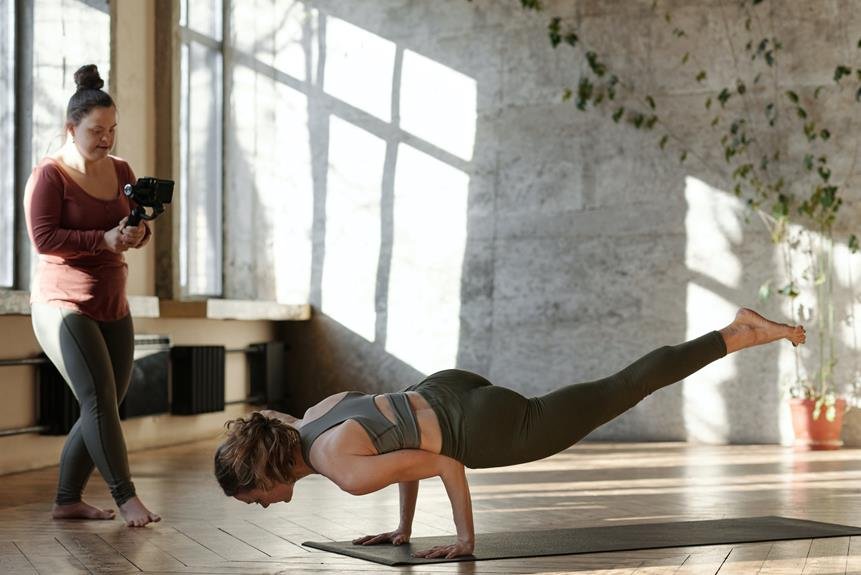
When we think about capturing a moment in time, we envision a crisp, clear image that freezes the essence of a scene. Imagine a world where every shot, no matter the conditions, is as steady as if the camera were on a tripod. In-body stabilization in mirrorless cameras brings us closer to this reality. The advantages of this technology are numerous, with benefits ranging from improved low-light performance to expanded lens compatibility. But it's not just about technical prowess; it's about the freedom to capture moments with unparalleled ease and precision.
Enhanced Low-Light Performance

With in-body stabilization, mirrorless cameras achieve enhanced low-light performance, ensuring sharp and clear images even in challenging lighting conditions. This technology allows for improved sharpness in photos by reducing the effects of camera shake, resulting in crisper, more detailed images, especially in dimly lit environments. Additionally, the in-body stabilization contributes to better video performance, as it minimizes the jittery and shaky footage often produced when shooting in low-light settings or using telephoto lenses.
The innovative in-body stabilization in mirrorless cameras is a game-changer for photographers and videographers alike. It opens up new possibilities for capturing stunning visuals in conditions that were previously considered difficult or even impossible. The ability to maintain image and video stability in low light not only expands creative opportunities but also ensures that the quality of the content remains uncompromised. Whether shooting handheld in a dimly lit room or capturing fast-moving subjects in the evening, the enhanced low-light performance provided by in-body stabilization empowers creators to push the boundaries of their craft and deliver exceptional results.
Expanded Lens Compatibility
As photographers and videographers, we continually seek equipment that offers expanded lens compatibility to broaden our creative possibilities and achieve our vision with greater flexibility. One of the key advantages of in-body stabilization in mirrorless cameras is its ability to improve stability, making it possible to use a wider range of lenses with confidence. In the past, certain lenses, especially older or manual focus ones, may have been limited in their adaptability to different camera bodies. However, with in-body stabilization, the playing field is leveled, and photographers can now explore a plethora of lenses, including vintage and third-party options, without compromising on image quality. This is particularly exciting for those who enjoy experimenting with unique focal lengths or specific optical characteristics that may not be readily available in modern lenses. The improved stability provided by in-body stabilization ensures that these lenses can be utilized to their full potential, opening up new creative avenues for photographers and videographers alike. The ability to adapt a wider range of lenses not only enhances the versatility of mirrorless cameras but also encourages innovation and pushes the boundaries of creative expression.
Increased Flexibility in Shooting Conditions

Improved stability provided by in-body stabilization allows photographers and videographers to capture high-quality images and footage in a wider range of shooting conditions, enhancing the overall flexibility of mirrorless cameras. With in-body stabilization, we can achieve steady shots in challenging environments such as low light settings or when capturing fast-moving subjects. This means that even in dimly lit areas, we can maintain image sharpness without relying heavily on artificial lighting or high ISO settings, preserving the natural ambiance of the scene. Additionally, in-body stabilization enables us to experiment with creative techniques like long exposure photography or capturing smooth, handheld video footage while on the move. The ability to shoot in various conditions without the need for a tripod not only saves time but also offers greater creative freedom. Whether we are shooting landscapes in uneven terrain, documenting events in dynamic settings, or pursuing spontaneous street photography, in-body stabilization empowers us to adapt swiftly to diverse shooting conditions, ultimately expanding the possibilities for visual storytelling.
Reduction of Handheld Shooting Limitations
In-body stabilization technology in mirrorless cameras significantly reduces limitations when shooting handheld, allowing for greater flexibility and creative freedom in capturing high-quality images and video footage. This improved stability empowers us to push the boundaries of traditional handheld shooting, opening up new possibilities for creativity and experimentation. With the reduction of handheld shooting limitations, we can confidently explore diverse shooting angles, panning shots, and low-light environments without being hindered by the risk of camera shake. This level of confidence and freedom enables us to capture moments with enhanced clarity and precision, ultimately elevating the overall quality of our visual storytelling. Moreover, the ability to shoot handheld with improved stability means we can adapt more seamlessly to dynamic shooting conditions, whether we're navigating through crowded spaces or capturing fast-paced action scenes. By mitigating the challenges associated with handheld shooting, in-body stabilization empowers us to unleash our full creative potential and deliver exceptional visual content that resonates with our audience.
Minimization of Post-Processing Requirements

With in-body stabilization technology, mirrorless cameras minimize the need for extensive post-processing adjustments, streamlining the workflow and allowing for more efficient and natural-looking results. This is particularly beneficial in terms of noise reduction and image sharpness. The in-body stabilization reduces the likelihood of camera shake, resulting in sharper images straight out of the camera. This means less reliance on software-based sharpening tools during post-processing, preserving the natural details of the image without introducing artifacts or digital noise. Additionally, the improved stability provided by in-body stabilization allows for lower ISO settings to be used in low-light conditions, further reducing the presence of noise in images. As a result, photographers can spend less time editing and more time capturing stunning photographs. This not only saves time but also ensures that the captured images retain their authentic qualities, meeting the demands of modern photographers who seek efficiency without compromising on the quality of their work.
Frequently Asked Questions
How Does In-Body Stabilization Affect the Overall Size and Weight of Mirrorless Cameras?
We've seen a significant impact on portability with in-body stabilization. It adds weight but enhances handling dynamics. The overall size doesn't increase drastically, making it a valuable addition for smoother, more stable shots.
Can In-Body Stabilization Be Turned off if I Prefer to Use a Different Stabilization Method?
Yes, in-body stabilization can be turned off if we prefer to use different stabilization methods. There are compatibility options for traditional methods, allowing us to employ different techniques based on our specific shooting needs.
Are There Any Specific Types of Photography Where In-Body Stabilization May Not Be as Effective?
In certain circumstances, in-body stabilization may not be as effective for specific types of photography, such as capturing fast-moving subjects or long telephoto shots. Understanding these limitations can help improve photographic outcomes.
Does In-Body Stabilization Have Any Impact on Battery Life?
Yes, in-body stabilization can impact battery life based on its usage. Stabilization techniques like gyroscopes and accelerometers consume power. However, advancements in technology and efficient power management mitigate these effects, enhancing photography experiences.
Can In-Body Stabilization Be Used in Combination With Lens-Based Stabilization for Even Greater Stabilization Benefits?
Yes, dual stabilization combines in-body and lens-based stabilization for optimal performance. It's compatible with various lenses and offers enhanced stabilization benefits. When compared to hybrid stabilization, the advantages in performance are evident, providing superior image quality.
